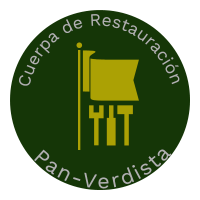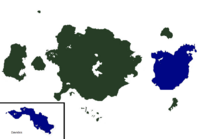Pan-Verdean Restoration Corps
| Cuerpa de Restauración Pan-Verdista | |
 | |
| Agency overview | |
|---|---|
| Formed | 18 de Mesjula DI 202 (18. January. 2002) |
| Preceding Agency |
|
| Jurisdiction | Verdean Union, Greater Meridon |
| Headquarters | Corazón del Río, Verde |
| Motto | "Soportar, Sustantair, Reconstruir" (Verdean: :"To Support, To Sustain, To Rebuild") |
| Employees | 2,250 |
| Annual budget | $12,210,400,068 |
| Agency executive | |
| Parent Agency | Verdean Union |
| Child agencies |
|
| Map | |
 Map of the current Verdean Union | |
This article is incomplete because it is pending further input from participants, or it is a work-in-progress by one author. Please comment on this article's talk page to share your input, comments and questions. Note: To contribute to this article, you may need to seek help from the author(s) of this page. |
The Pan-Verdean Restoration Corps (Verdean: La Cuerpa de Restauración Pan-Verdista) is a multinational organization, an Agency, part of the Verdean Union dedicated to developing the ethnically Verdean nations of Greater Meridon and Especia, and particularly recovering from the damage caused by decades of civil strife and destructive exploitation at the hands of the Federal Republic of Capisaria. The Pan-Verdean Restoration Corps is perhaps the largest single foreign aid agency in Tara in terms of volunteers and employees and one of the largest by budget.
History
After the conclusion of the Capisarian Revolution, and the liberation of the Verdean Archipelago from occupation, much of the territory of the newly independent Verdean states were in states of extreme disrepair. Decades of military occupation, resource extraction, and the destructive economic reforms made at the behest of the Capisarian government and Capisarian corporations had ravaged the Verdean economies and left a lot of economic infrastructure in a state of disrepair. Most Verdean governments, particularly those of Verde, Plata, and Dorado, made attempts to reconstruct their economies on a national level. Such efforts were promising, but aside from Verde, which had been least devastated by the occupation, were hampered by relatively small budgets available for reconstruction.
When the Verdean Union was founded in DI 200, there were hopes that there would be greater cooperation between the Verdean states, particularly in the field of economic development. The Verdean Central Council was slow to act however, and it was ultimately up to the Republic of Verde, and its own national program to become the basis of the Pan-Verdean Restoration Corps. Restructuring the national scale Verdean office to an international organization proved difficult, and the first major project, as a result did not begin until DI 203. The construction of several transport infrastructure works in Plata marked the beginning of PVRC operations.
The Pan-Verdean Restoration would undergo a shift from a professional organization, to a primarily volunteer organization after political pressure from Verde was applied, specifically to reduce the overall cost of operations, and to better involve Verdean citizens completing their National Service. There were problems from this reorganization, and many projects had to be put on hold to retrain staff. But by DI 209, efforts had proven ultimately successful. It was also during this time that the PVRC began to expand operations, as early projects had been orientated to physical reconstruction. Offices dedicated to human development were opened in DI 207, 209, and 211 with the Offices Medicines and Disaster Relief, Office of Education, and the Office of Cultural Development respectively.
The most challenging engagement of the PVRC's history came in DI 212 when the Verdean Republic was struck by a nuclear attack from Dorado. This attack, and the subsequent Doradan War proved to be the most significant disaster in the Verdean Archipelago since the inception of the PVRC. Several projects were initiated in the aftermath of the nuclear attack, primarily to clean up and reconstruct the city of Bastille, and proved enormously popular in spite of the danger posed by working in a radioactive zone. After active hostilities in Dorado came to an end, development operations commenced in Dorado to repair the damage caused by the conflict. These projects saw the numbers of the PVRC swell to nearly four hundred thousand volunteers. As the reconstruction operations in Verde come to a close, the PVRC looked to expand the scope of its operations outside the Verdean Archipelago with the first project, an educational program in Davidos, starting in DI 218.